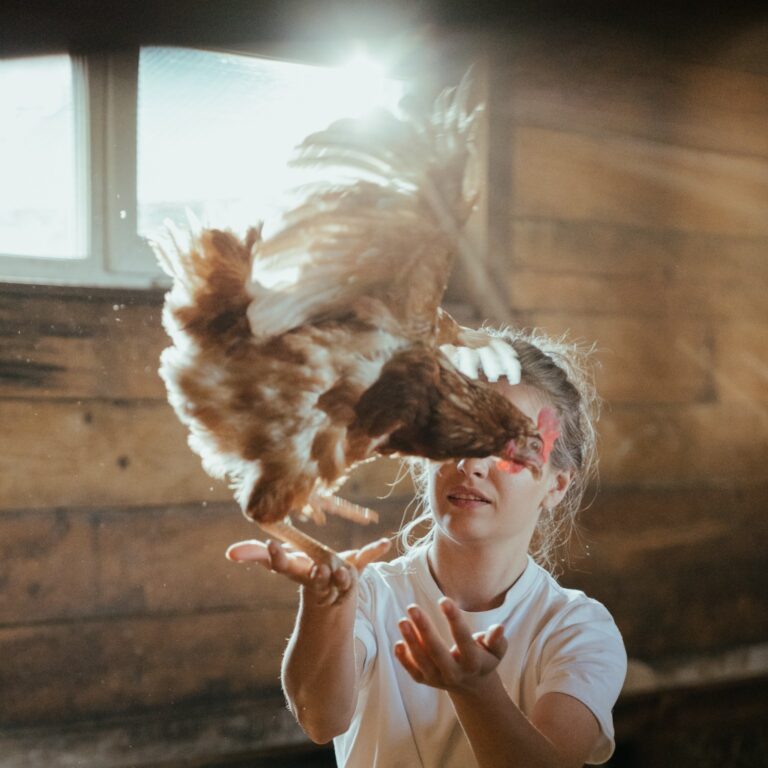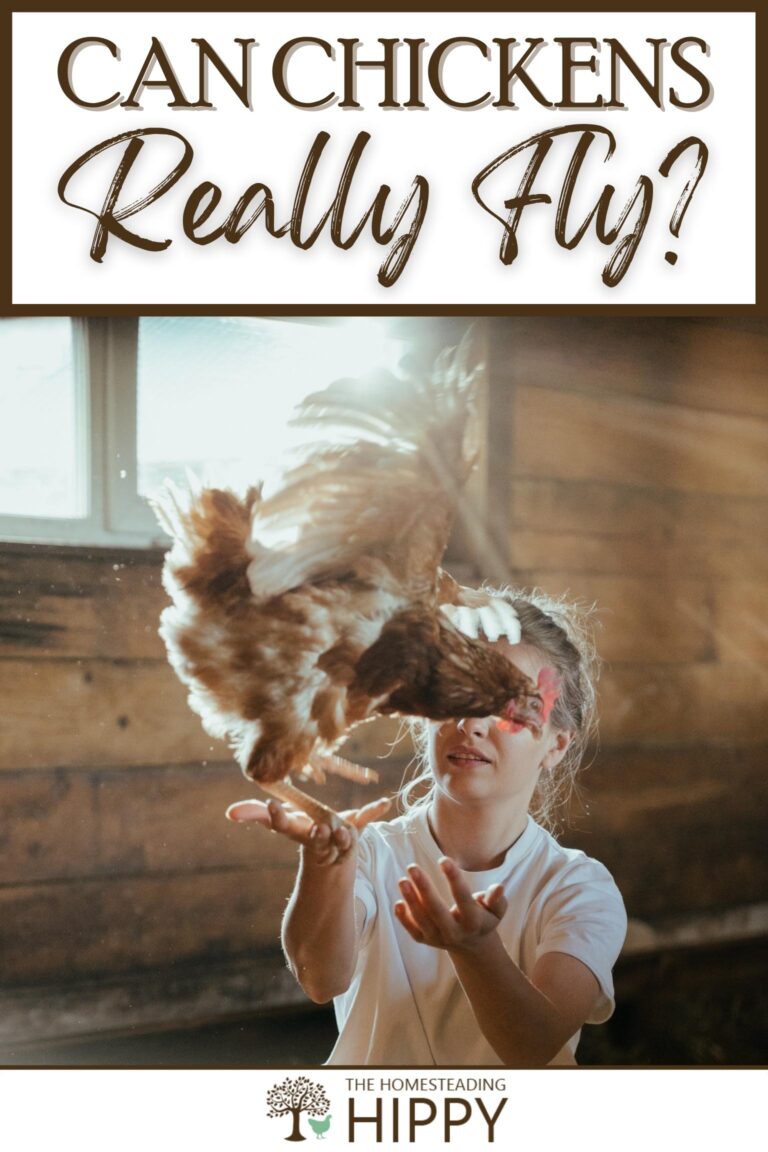There is a lot of debate surrounding whether or not chickens can actually fly. Some people swear that they have seen them take flight, true flight over long distances, while others are adamant that this is simply not possible, and chickens are only capable of fluttering glides over short distances.

So, what is the truth? Are chickens able to get airborne, or are they doomed to walk around on the ground all their lives? Can chickens really fly?
Yes, chickens can fly, but generally only in short bursts – so they’re not truly flightless birds. Most chicken breeds are capable of limited flight to escape predators or reach roosting areas.
Depending on the breed, they may be able to attain greater heights or distances, but some have lost the ability to fly through long domestication. Owners may choose to trim the flight feathers of their chickens in order to limit flight ability.
Hard-hitting answers to the questions that matter. In this article, we will explore the evidence for and against chicken flight and learn a little bit more about our feathered friends.
Most Domestic Chickens are No Longer Properly Adapted for Sustained Flight
It is true that most domesticated chicken breeds are not well-adapted for sustained flight. Chickens have been bred over the years for egg production, meat production, and certain aesthetic qualities such as feathering.
This has led to chickens that are larger than their wild ancestors and often quite different in appearance. These chickens typically have shorter wings and more muscular breasts when compared to wild birds.
Counter-intuitively, this can make chickens less capable of flight since it greatly increases their overall mass. As a result, many are not able to fly for long periods of time or cover great distances.
Most Chicken Breeds are Capable of Limited Flight or “Hops”
Even so, the majority of chicken breeds are still capable of some form of flight or what is sometimes called a “hop” or burst flight.
This means that they are able to get airborne for short periods of time, usually no more than a few seconds. Chickens typically use this ability to cover ground quickly, escape danger or reach higher ground.
However, some chickens can stay aloft for quite a while, though nowhere near the seemingly unlimited flight time of other birds.
The longest recorded flight by a chicken was 13 seconds, achieved by a breed called the Redcap in 2014. This breed is known for its “old world” features and sinewy, slight build which can give it optimal flight performance… for a chicken.
While there have been reports of chickens flying over long distances, these are most likely cases of birds being carried by the wind or even gliding downhill rather than an actual, sustained flight on their own merits.
Some Breeds Fly Better than Others
Not all chickens are saddled with terrible flight characteristics. There are actually a number of chicken breeds that are known for their flying abilities. These include the Aseel, Minorca, and Speckled Sussex.
If you come across any breed of chicken that is known for roosting in trees, patrolling roofs, escape attempts, and other such trickery, you’ll know why: it is because they are good flyers!
Poor flyers could never attain such heights, and chickens cannot really climb, so there you have it.
While these breeds may be better equipped for flight than most, they still pale in comparison to other birds when it comes to getting airborne.
Some Cannot Fly at All
However, some chicken breeds are particularly poor flyers, to the point that their average flight is more of a fluttering, flapping leap than anything resembling the glide of a bird.
This may be because of their size, a loss of characteristic flight feathers, or other reasons.
Some such species include Orpingtons, Silkies, and many Bantams. Any of the largest breeds are unlikely to attain meaningful flight at all.
If you encounter or learn about a breed that is known as low roosting, easy to contain, and so forth, you can depend on them being poor fliers- no clipping necessary!
When will Chickens take to the Air?
Want to observe for yourself? Not sure if your chickens are flying free when you aren’t around? When do chickens typically take flight?
Well, chickens are most likely to take to the air for any of the following reasons:
When startled or alarmed. Loud sounds or sudden, sharp movements well usually promote an entire group of chickens to take flight in a noisy fluttering of wings and clucking. Most keepers have experienced this at one time or another for various reasons.
To escape predators or harassment. Chickens that notice the presence of a predator will invariably move at best speed to get away from it or reach safety, and that usually entails flying if they are able.
Even ground-bound birds might flap their wings as if they were flying as they run along the ground, so ingrained is the instinct. Similarly, if any chicken is facing persistent harassment from another chicken, they might be prompted to fly away.
When chasing insects. Chickens love to eat insects, of all kinds, and pretty much everything they can catch. If a large beetle or grasshopper takes to wing in an attempt to escape, the chicken might do likewise in an effort to catch it and eat it.
To roost. Chickens prefer to roost up off the ground in an attempt to keep themselves and their eggs safe from predators.
For many breeds, higher is better, and they will happily fly up to low branches and other overhangs if they can reach them when it is time to bed down for the night.
To get a higher vantage point. Some chickens that are keeping a lookout on the rest of the flock, and roosters in particular, prefer to perch on a high place so they can better survey their domain.
Keepers may Decide to Clip Wings to Prevent Escape or Mischief
Even if a given breed or individual chicken is flight-capable, owners might not want that to be so, for a variety of reasons.
This is usually to prevent escape from enclosures, to keep chickens from roosting in out of the way places, or to make them easier to catch- it helps when they cannot fly away!
In these and other cases, keepers might decide to clip a chicken’s wings in order to keep them from flying away or getting to places they shouldn’t be.
Though “clipping” sounds painful or injurious, it isn’t so long as it is done with skill and care. It won’t even hurt the chicken!
It might surprise you to learn, though, that the process of clipping a bird’s wings is not as simple as snipping off a couple of feathers and calling it good. In fact, it requires a fair amount of skill and knowledge to do it properly.
The first step is to identify the wing primaries, which are the longest feathers on the wing. These are the feathers that provide the most lift, so it’s important to clip them in such a way that they will still be able to provide some lift.
Next, the secondary feathers must be identified. These are shorter than the primaries and are located closer to the body. It’s important not to clip too many of these, as they provide stability and help the bird maneuver.
Finally, the tertiaries can be trimmed if desired. When done correctly, wing clipping can help to keep a chicken mostly grounded and safe without removing its ability to fly entirely.
If it sounds cruel, keep in mind that chickens are highly sought-after by many predators, and if allowed to roam outside the protection keepers set up for them can quickly be picked off. Clipping their wings ensures they will remain where you want them, safe and sound.

Tom has built and remodeled homes, generated his own electricity, grown his own food and more, all in quest of remaining as independent of society as possible. Now he shares his experiences and hard-earned lessons with readers around the country.
Find out more about the team here.

That’s why the breast and wing meat on a chicken is white instead of dark. If they were long-flying birds that white meat would be dark.